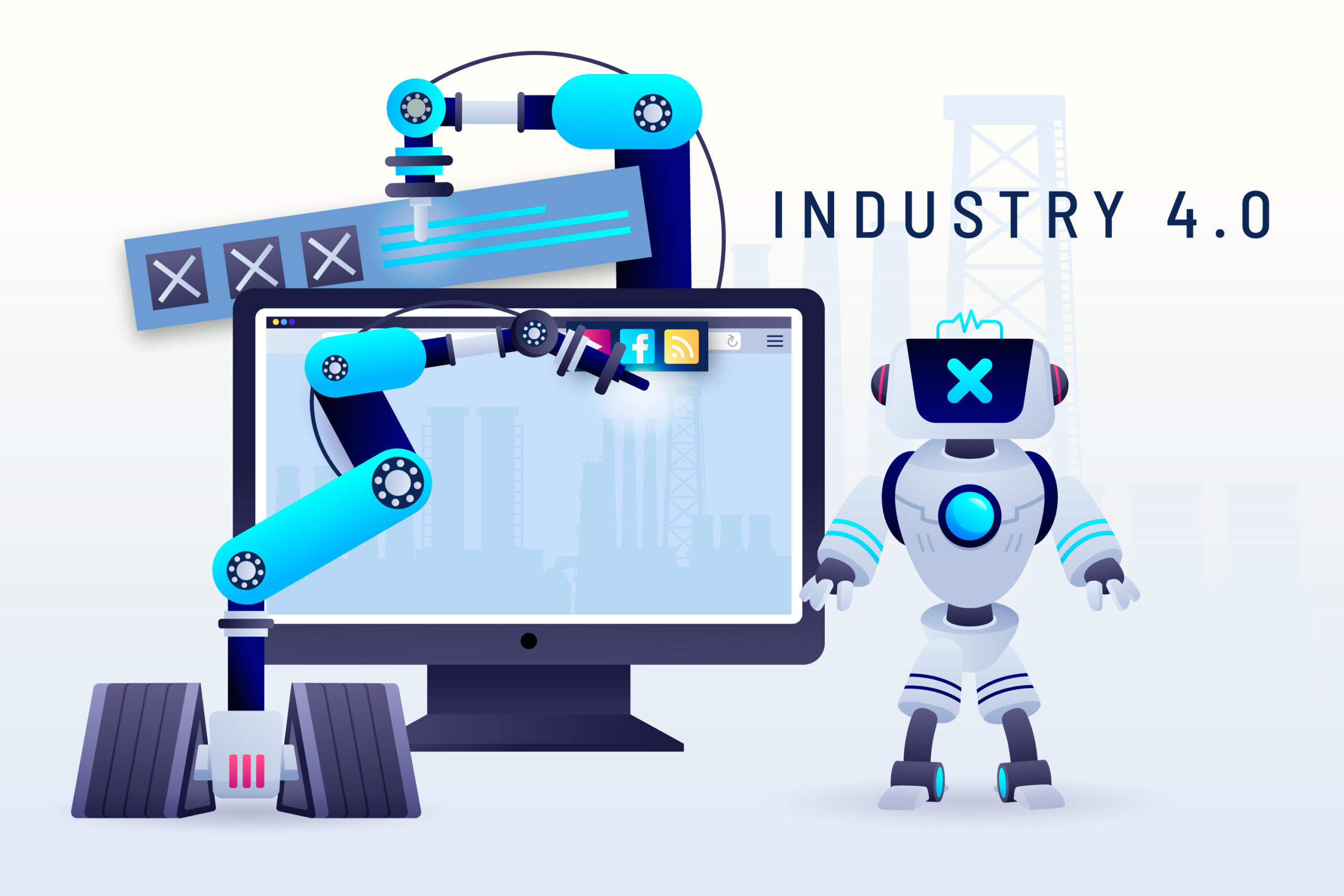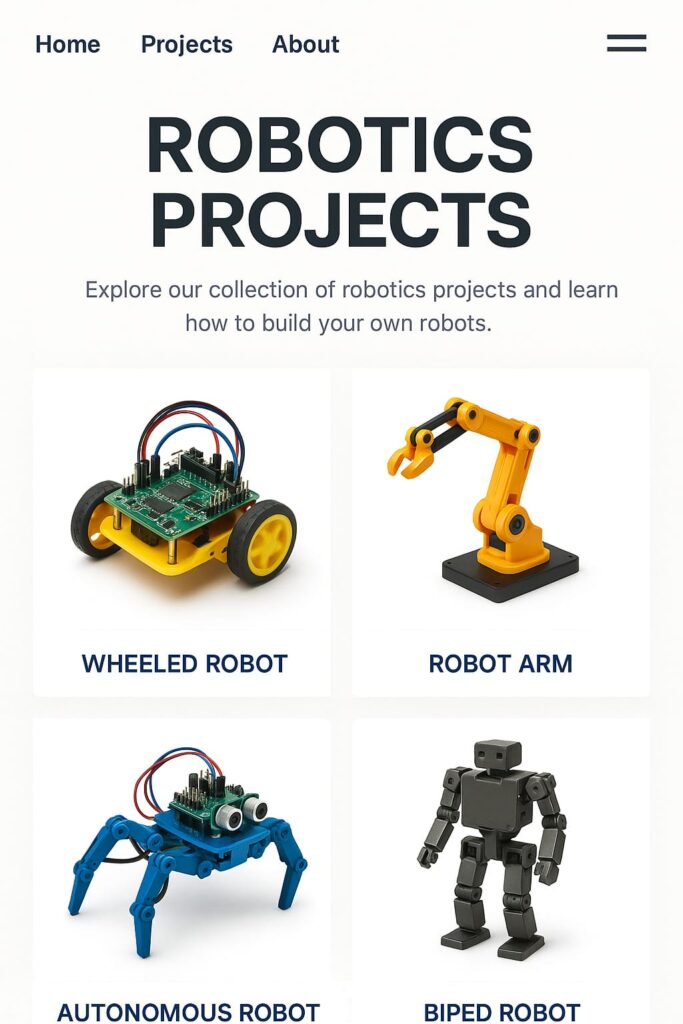Website for Robotics Projects: Why Every Project Needs One

In the rapidly evolving tech world, robotics projects are no longer limited to labs or academic journals. From college competitions to startup innovations, robotics is everywhere. But how do you showcase your work to the world? The answer lies in having a website for robotics projects. It acts as a digital face—demonstrating your efforts, attracting collaborators, and documenting milestones.This blog is a part of our Service Web designing.
Table of Contents
What Is a Website for Robotics Projects

A website for robotics projects is a centralized online platform that showcases your robotic inventions, technical details, updates, and team behind the innovation. Unlike a résumé or one-pager, it provides a comprehensive, searchable, and visually engaging representation of your work.
You can use it to:
- Share project summaries
- Upload images, videos, and simulations
- Publish technical documentation
- Provide access to source code via GitHub
- List contact details or inquiry forms
It serves as a public portfolio and an archive of your project’s journey.
Why Every Robotics Project Needs a Website
Establishes Professionalism
Whether you’re a student team entering a competition or a robotics startup, a polished website instantly enhances your credibility. It makes your project look well-organized, researched, and investment-ready.
Enhances Discoverability via Search Engines
By optimizing your content for SEO (especially using your focus keyword “website for robotics projects”), your project becomes easier to find on Google. This increases chances of being noticed by the right audience—investors, collaborators, recruiters, or customers.
Makes Project Information Accessible
Rather than sending individual presentations or portfolios, you can direct interested people to your website. Everything from videos to schematics is just one click away.
Supports Funding and Grant Applications
Most grants and startup accelerators ask for your digital presence. A well-maintained website can impress evaluators and strengthen your application.
Builds an Online Portfolio
A website is your living résumé. Whether you’re applying for jobs or presenting your project at a tech fair, a link to your website adds value. It shows initiative, communication skills, and technical capability.
Robotics Website Essentials
If you’re ready to build your site, here’s what it should include:
Homepage
Clear tagline, engaging images, and a short overview of your project.
Project Overview Page
Explain the problem you’re solving, the tech used, and the expected impact.
Technical Documentation
Share CAD drawings, code repositories, bill of materials (BOM), and test results.
Media Gallery
Videos of your robot in action, photos from different development stages.
Blog or Update Section
Share weekly or monthly progress, challenges faced, and new features added.
About the Team
Include bios, roles, photos, and LinkedIn profiles of team members.
Contact & Collaboration
Form or email for inquiries, feedback, or collaborations.
Call-to-Action Buttons
Examples: “Download Full Report”, “Visit GitHub“, “Join Our Newsletter”, “Donate”
Best Platforms to Create a Robotics Website
You don’t need to be a web developer to build a stunning robotics project site. Here are some popular platforms:
- GitHub Pages – Perfect for tech-savvy users, free and fast.
- WordPress – Great for content-heavy sites with flexibility.
- Wix / Webflow – Drag-and-drop platforms for beginners.
- Notion (Public Pages) – Minimal and quick project displays.
Choose the platform that best suits your team’s skills and content needs.
SEO Optimization Tips for Robotics Project Websites
To get found on Google, follow these key strategies:
- Use your focus keyword “website for robotics projects” in your title, meta description, headings, and URLs.
- Include image alt-text (e.g., “robot arm demo 2025”).
- Use internal linking (from blog to project page, etc.).
- Keep content fresh with updates or news.
- Make your website mobile-friendly and fast-loading.
These steps not only improve visibility but also enhance user experience.
Showcase of Real Robotics Websites
Here are some real-world examples that have benefited from having a website for robotics projects:
- Team CoBot (Carnegie Mellon) – Their site features real-time updates, videos, and a detailed project breakdown.
- ANYbotics (Swiss robotics company) – Clean layout, professional branding, and investor resources.
- RoboCup Teams – Most university teams have dedicated sites for competition entries and updates.
Each example proves how a good website can elevate a project’s public perception.
Common Mistakes to Avoid
While building a website for robotics projects, many teams and individuals make common errors that can reduce its effectiveness and impact. Avoiding these pitfalls will ensure your site is both professional and user-friendly.
Using Too Much Technical Jargon Without Context
It’s easy to fill your site with technical terms and robotics lingo, but this can alienate non-technical visitors like potential investors, media, or new students. Make sure to explain your concepts in a way that’s understandable to a broader audience.
✅ Tip: Add a glossary or use simple analogies alongside technical content.
Lack of Clear Structure or Navigation
One of the biggest issues with poorly built robotics websites is messy or confusing navigation. If users can’t easily find information—like project goals, media, or documentation—they’ll leave quickly
Not Showcasing Visuals or Demonstrations
A website for robotics projects without photos, demo videos, or animations is like a robot without sensors—blind and ineffective. Visual content captures attention and helps communicate complex ideas quickly.
Include: YouTube demo embeds, image sliders, CAD model snapshots, simulation gifs, etc.
Forgetting to Optimize for Mobile Devices
With the majority of users browsing via smartphones, a site that isn’t mobile-friendly will lose half its audience. Google also prioritizes mobile-optimized pages in search rankings.
Ensure: Responsive design, readable fonts, and fast loading across all devices.
Not Using the Focus Keyword Strategically
If you want your website for robotics projects to rank on search engines, you need to use the right keywords. Many developers forget to include their focus keyword in page titles, meta descriptions, and image alt text.
SEO Reminder: Naturally integrate “website for robotics projects” in your homepage, blog content, and image tags without keyword stuffing.
Missing Call-to-Action (CTA)
After viewing your website, what should the visitor do? Many robotics sites miss this opportunity to engage. Whether it’s “Download Our Report,” “Watch the Robot Demo,” or “Follow Us on GitHub,” a strong CTA guides user interaction.
Add CTAs: Strategically place CTAs on the homepage, project page, and blog posts.
Outdated or Incomplete Content
Launching your site is just the beginning. If you stop updating it, it reflects poorly on your robotics project. Stale content suggests inactivity, even if the project is still in progress.
Maintain: Add monthly updates, post progress blogs, or link new versions of your documentation.
No Contact Information or Inquiry Form
Many visitors—including potential sponsors or collaborators—might want to reach you. Not including a clear contact method is a lost opportunity.
Include: Contact form, email address, social links, or even a Discord/Telegram channel.
By avoiding these mistakes, your website for robotics projects will stand out as a professional, user-friendly, and well-optimized platform that truly reflects the innovation behind your robotics work.
Which Website Is Best for Learning Robotics?
To level up your skills or get inspired, check out these top resources:
Coursera
Offers university-level robotics courses from institutions like UPenn, Penn State, and more. Certificates available.
MIT OpenCourseWare
Free, in-depth courses and lecture notes. Ideal for self-paced learners.
Arduino Project Hub
Beginner-friendly projects with schematics and code—perfect for hardware-based learning.
ROS.org (Robot Operating System)
Excellent for learning robotics software, used in academia and industry.
edX and Udacity
Both platforms provide project-based learning in AI, automation, and robotics foundations.
These platforms can help you build better, smarter robotics projects—and your website can reflect what you’ve learned.
How to Promote Your Website for Robotics Projects
Creating a website for robotics projects is only half the job—promoting it ensures your work gets noticed. Here’s how:
- Share on Social Media
Post project updates, demos, and behind-the-scenes content with links to your website. - Engage in Robotics Communities
Join forums like Reddit (r/robotics), Hackster.io, and Stack Exchange. Share your site for feedback and visibility. - Upload to YouTube
Create short videos of your robot in action. Add your website link in the video description. - Link from GitHub
Add your website to your GitHub README if you’re sharing code. - Submit to Blogs or Newsletters
Write guest posts or share your project story with engineering blogs and student publications.
Promoting your website for robotics projects expands its reach, helping you connect with collaborators, mentors, and potential investors.
Having a website for robotics projects is no longer a luxury—it’s a necessity. It transforms your offline work into a shareable, impactful online experience. From showcasing your prototype to impressing investors or applying for tech internships, a website acts as your most powerful digital tool.
So, whether you’re a high school team building your first line-following robot or a startup developing warehouse automation, build that website. Let your innovation be seen, shared, and celebrated.
